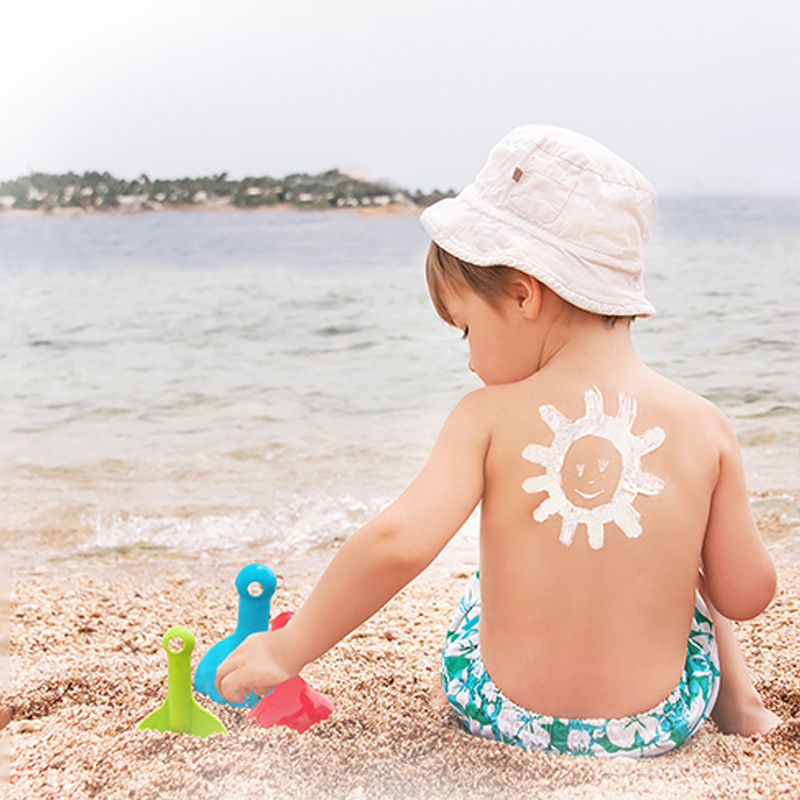Sun Safety can be a huge hassle when you have babies and young kids. Certain questions keep plaguing all parents’ minds like is Sunscreen safe for a Baby? How much time in the sun should you give your kid? Which sunscreen to use? How to protect from Sun Damage? Read on to know more about the potential damage that excessive sun exposure can cause and why you need a good sunscreen for babies now.
Is Sun exposure really harmful?
Yes, yes and yes! Prolonged and unprotected sun exposure can be really harmful for your baby’s as well as your skin. Excessive exposure to the sun’s UV rays can cause skin damage, tanning, burns, eye damage, low immunity, and skin cancer.
The sun’s rays consist of invisible UV rays.
- UVA rays cause skin ageing and wrinkling and contribute to skin cancer, such as melanoma (the most dangerous form of skin cancer).
- UVB rays are also dangerous, causing sunburns, cataracts (clouding of the eye lens), and effects on the immune system.
UV rays react with a chemical called melanin that’s found in the skin. When the level of UV exposure is greater than the protection offered by melanin, a sunburn develops. A tan is itself a sign of skin damage and does not help protect the skin.
Do Children need Sun Protection?
Every child needs sun protection. Children have really delicate and sensitive skin, so it’s all the more imperative to protect from these harmful effects!
A lot of people assume that darker-skinned children and adults don’t need sunscreen, but that’s a myth! The lighter someone’s natural skin colour, the less melanin it has to absorb UV rays and protect itself. The darker a person’s natural skin color, the more melanin it has. But both dark- and light-skinned kids need protection from UV rays because any tanning or burning causes skin damage.
How to protect your children from Sun’s Harmful Rays.
-
Use Sunscreen for Babies too!
The AAP recommends using sunscreen on children above 6 months of age. Use a Mineral based sunscreen that’s at least SPF 15. Apply the sunscreen to your child’s exposed skin areas before they step out in the sun and re-apply every 2 hours.
How to choose sunscreen for babies?

There are 2 types of sunscreens available in the market – Chemical sunscreens & Mineral-based sunscreens. AAP recommends using a mineral based sunscreen over a chemical sunscreen on your baby’s skin. The sunscreens should ideally offer both UVA & UVB protection and if your kids are going to be around water then make sure it’s water & sweat resistant.
Try The Mom’s Co’s Natural Mineral Based Sunscreen for babies.A mineral-based sunscreen, it’s SPF 50, offers both UV-A & UV-B protection & is water and sweat resistant.
-
Avoid peak sun hours
It’s best to avoid taking your baby out in the sun from 11 am – 4 pm, when the sun is at it’s strongest. If kids have to be out of the house at this time then make sure you’re applying sunscreen and re-applying it every 2 hours. You don’t use sunscreen just when you’re going to the beach, maximum sun exposure happens during day-to-day activities. We tend to assume that if it’s a rainy or cloudy day, sunscreen isn’t required. When in fact, as per the American Association of Dermatologists, you need sunscreen every time your baby is going out. Rain or sunshine, beach or car, your child needs sunscreen!
-
Cover up
We know it’s difficult in this sweltering heat, but it’s best to make your baby wear full sleeved clothes that offer maximum protection from the sun. To make sure clothes offer enough protection, put your hand inside garments to make sure you can’t see it through them.
-
Use accessories
If you are taking your baby out in the sun then try and use sunglasses, wide-brimmed hats, umbrellas and other accessories that offer as much shade as possible.
With increasing pollution and depleting ozone layer, it’s become more important than ever now to protect ourselves and our children from the harmful effects of the sun. Let’s take the necessary steps and precautions to ensure that our children are protected from the sun’s harmful rays. Here’s our guide to Swimming for Babies: All you Need to Know.

